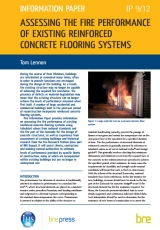Assessing the fire performance of existing reinforced concrete flooring systems IP 9 12
BRE (Building Research Establishment) is an independent, research-based consultancy, testing and training organisation, operating in the built environment and associated industries.
Assessing the fire performance of existing reinforced concrete flooring systems (IP 9/12) was written by Tom Lennon and published by BRE on 27 March 2012.
During their lifetimes, buildings may be refurbished or renovated, often to provide functions not envisaged when they were originally designed. As a result, their structure may no longer achieve the required fire resistance, and defects or material degradation may mean it no longer achieves the performance assumed when it was built.
This 12-page information paper provides guidance on assessing the fire performance of reinforced concrete flooring systems, which were often used in large buildings built in the post-war period. It provides information about carrying out assessments using tabulated values from national standards and the Eurocode for the design of concrete structures, as well as experience and research by the Fire Research Station (now part of BRE Group).
It will help clients, contractors and building control bodies estimate the levels of performance provided by different forms of construction, many of which are no longer in widespread use.
The contents of the information paper are:
- Introduction.
- Concrete in fire.
- Tabulated data for reinforced concrete floors.
- Alternative forms of construction.
- Methods to enhance the fire resistance of existing floor systems.
- Conclusions.
- References.
[edit] Find out more.
[edit] Related articles on Designing Buildings Wiki
- Approved document B.
- BRE articles on Designing Buildings Wiki.
- BRE Buzz articles on Designing Buildings Wiki.
- BRE Buzz.
- BS 9999.
- Building Research Establishment.
- Concrete and fire safety.
- Concrete.
- Fire performance of external thermal insulation for walls of multistorey buildings, third edition (BR 135).
- Fire protection engineering.
- Fire.
- Managing fire risk in commercial buildings: A guide for facilities managers.
- Managing risks in existing buildings: An overview of UK risk-based legislation for commercial and industrial premises (FB 86).
- Reinforced concrete.
Featured articles and news
The UK's Modern Industrial Strategy: A 10 year plan
Previous consultation criticism, current key elements and general support with some persisting reservations.
Building Safety Regulator reforms
New roles, new staff and a new fast track service pave the way for a single construction regulator.
Architectural Technologist CPDs and Communications
CIAT CPD… and how you can do it!
Cooling centres and cool spaces
Managing extreme heat in cities by directing the public to places for heat stress relief and water sources.
Winter gardens: A brief history and warm variations
Extending the season with glass in different forms and terms.
Restoring Great Yarmouth's Winter Gardens
Transforming one of the least sustainable constructions imaginable.
Construction Skills Mission Board launch sector drive
Newly formed government and industry collaboration set strategy for recruiting an additional 100,000 construction workers a year.
New Architects Code comes into effect in September 2025
ARB Architects Code of Conduct and Practice available with ongoing consultation regarding guidance.
Welsh Skills Body (Medr) launches ambitious plan
The new skills body brings together funding and regulation of tertiary education and research for the devolved nation.
Paul Gandy FCIOB announced as next CIOB President
Former Tilbury Douglas CEO takes helm.
UK Infrastructure: A 10 Year Strategy. In brief with reactions
With the National Infrastructure and Service Transformation Authority (NISTA).
Ebenezer Howard: inventor of the garden city. Book review.
The Grenfell Tower fire, eight years on
A time to pause and reflect as Dubai tower block fire reported just before anniversary.
Airtightness Topic Guide BSRIA TG 27/2025
Explaining the basics of airtightness, what it is, why it's important, when it's required and how it's carried out.
Construction contract awards hit lowest point of 2025
Plummeting for second consecutive month, intensifying concerns for housing and infrastructure goals.
Understanding Mental Health in the Built Environment 2025
Examining the state of mental health in construction, shedding light on levels of stress, anxiety and depression.























